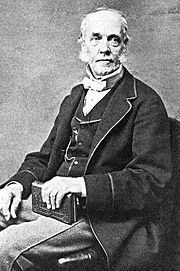William Lassell facts for kids
Quick facts for kids
William Lassell
|
|
|---|---|
 |
|
| Born | 18 June 1799 Bolton, England
|
| Died | 5 October 1880 (aged 81) Maidenhead, England
|
| Known for | Discovered the moons Triton, Hyperion, Ariel and Umbriel |
| Awards | Gold Medal of the Royal Astronomical Society (1849) Royal Medal (1858) |
| Scientific career | |
| Fields | Astronomer |
William Lassell (born June 18, 1799 – died October 5, 1880) was an English merchant who became a famous astronomer. He is known for making better reflecting telescopes and for discovering four moons around different planets.
Contents
Early Life and Passion for Astronomy
William Lassell was born in Bolton, England. He went to school in Bolton and then at Rochdale Academy. When his father passed away, William became an apprentice to a merchant in Liverpool from 1814 to 1821.
He later became very successful as a beer brewer. This success allowed him to follow his big interest in astronomy.
Building Observatories and Telescopes
Lassell built his own observatory at his home called "Starfield" in West Derby, near Liverpool. Here, he had a special telescope. It was a metal mirror reflector telescope with a 24-inch (610 mm) wide opening. People often called it the "two-foot" telescope.
He was one of the first to use an equatorial mount for his telescope. This mount made it much easier to follow objects in the sky as the Earth spins. Lassell even made the telescope's mirror himself, grinding and polishing it with tools he built. In 1854, he moved his observatory to Bradstone, a bit further from Liverpool.
Amazing Discoveries
Lassell made some incredible discoveries using his homemade telescopes:
- In 1846, he discovered Triton. This is the biggest moon of Neptune. He found it just 17 days after Neptune itself was discovered!
- In 1848, he also found Hyperion, one of Saturn's moons.
- In 1851, he discovered two more moons: Ariel and Umbriel. These moons orbit the planet Uranus.
Later Years and Legacy
In 1855, Lassell built an even bigger telescope, a 48-inch (1.2 m) one. He set it up in Malta because the sky there was much clearer for observing than in cloudy England. After several years in Malta, he returned to the UK. He moved to Maidenhead and continued to use his 24-inch telescope there. The giant 48-inch telescope was taken apart and eventually scrapped. His 24-inch telescope was later moved to the Royal Observatory, Greenwich in the 1880s, but it was also later taken apart.
Lassell was a very respected astronomer.
- He became a member of the Royal Astronomical Society in 1839.
- He won the Gold Medal of the Royal Astronomical Society in 1849.
- He was even the president of the Royal Astronomical Society for two years, starting in 1870.
- He was also elected a member of The Royal Society in 1849 and won their Royal Medal in 1858.
William Lassell passed away in Maidenhead in 1880. He is buried at St. Luke's Church.
To honor his work, several things in space are named after him:
- A crater on the Moon is called Lassell.
- A crater on Mars is also named Lassell.
- The asteroid 2636 Lassell is named after him.
- One of the rings of Neptune also carries his name.
At the University of Liverpool, there is a special award called the William Lassell prize. It is given every year to the student with the best grades in the Physics with Astronomy program.
See also
 In Spanish: William Lassell para niños
In Spanish: William Lassell para niños
- List of largest optical telescopes in the 19th century

